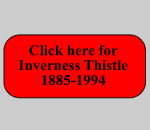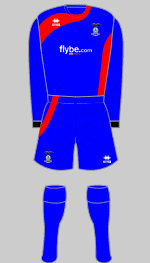



Inverness
Caledonian Thistle
Formed 1994 by the merger of Caledonian and Inverness Thistle
Elected to Scottish Division Three 1994
Kit History
Caledonian Thistle
1994

1994-1995 a
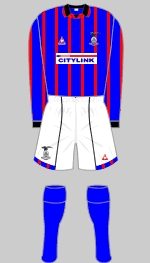
1995-1996 a b h
Inverness Caledonian Thistle
1996
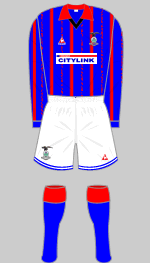
1996-1997 a b
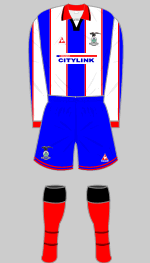
1997-1998 a
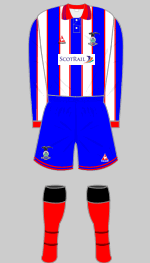
1998-1999 a
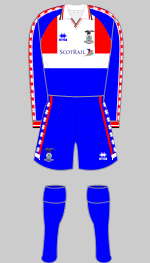
1999-2000 a
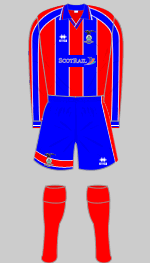
2000-2001 a
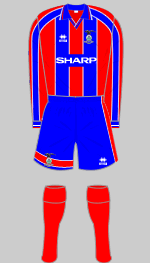
2001-2002 a
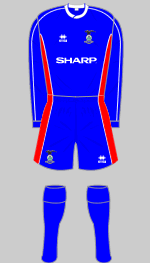
2002-2003 a
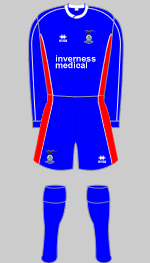
2003-2004 a
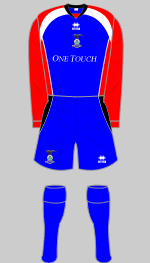
2004-2006 a b
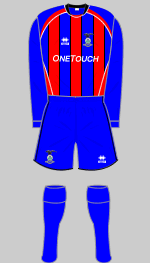
2006-2007 a i
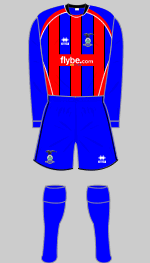
2007-2008 g i
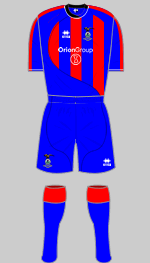
2010-2012 g i
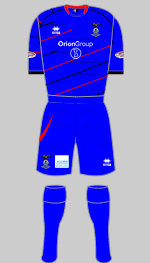
2012-2014 g
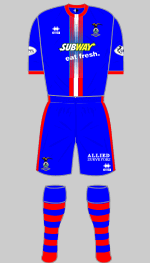
2014-2015 g
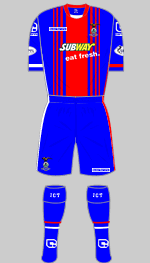
2015-2016 g
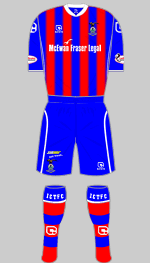
2016-2017 g
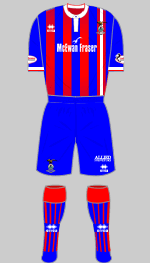
2017-2018 g
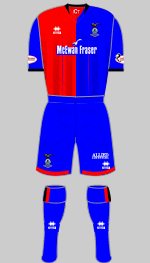
2018-2019 g
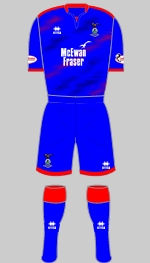
2019-2020 g
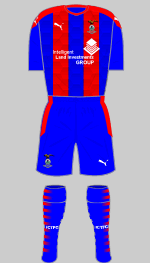
2020-2021 g
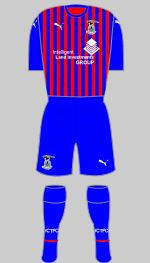
2021-2022 g
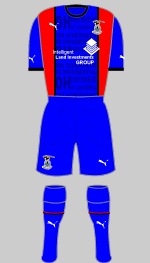
2022-2023 g
Background
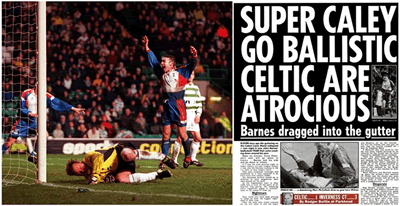 In the modern era, amalgamating
two professional clubs is often proposed but rarely achieved. Invariably economic
logic is overwhelmed by tradition and the deep running loyalties built up in many cases over more
than century. The story of Inverness Caledonian Thistle is therefore
something of an exception.
In the modern era, amalgamating
two professional clubs is often proposed but rarely achieved. Invariably economic
logic is overwhelmed by tradition and the deep running loyalties built up in many cases over more
than century. The story of Inverness Caledonian Thistle is therefore
something of an exception.
Inverness Thistle FC and Caledonian FC were both formed in 1885. The following year a third senior club was formed in the city, Clachnacuddin. These three went on to help form the North of Scotland FA and in 1893 they became founder members of the Highland League. “Clach” enjoyed considerable success in the first half of the twentieth century, winning 16 titles. Thereafter, it was “Caley” (18 titles) and Thistle (8 titles) that dominated.
Because of the considerable distances involved, the clubs from the central belt who dominated the Scottish Football League did not welcome applications to join their ranks from the northern clubs and the Highland League existed in splendid isolation for over a century, regarded as the strongest of the non-league competitions in Scotland. The four semi-finalists in the Northern Qualifying Cup were rewarded with a place in the Scottish Cup First Round the following season, the only chance for the Highland clubs to compete against their southern rivals. While the Scottish League sides usually got the best of these encounters, the Highland League teams earned considerable respect.
In 1993 the Scottish Football League announced plans for reorganisation that would create two additional places. At the urging of the Nairn & Inverness Enterprise
Company, a proposal for a joint submission was prepared. Initially all three Inverness sides were involved but Clachnacuddin
dropped out and after considerable wrangling Caledonian and Thistle submitted
a joint application to the Scottish League in January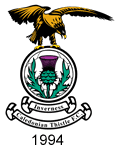 1994. The Inverness
clubs topped the poll with fellow Highland league side Ross County in
second place.
1994. The Inverness
clubs topped the poll with fellow Highland league side Ross County in
second place.
The last ever derby between the two sides was played May 11th 1994 (Caley won 1-0) and three days later both clubs played their final matches as separate clubs. During the close season arguments and threats of legal action continued and the future of the merged club was in considerable doubt but somehow compromise solutions were found, including a new name – “Caledonian Thistle”. Naturally enough the new crest combined the two motifs of the older clubs, a golden eagle (for Caledonian) and a Scottish Thistle.
The new club had committed to build a new stadium
within a year in their application but legal challenges and the complexity
of the financial arrangements caused delay and it was not until October
1996 that the rebuilding of Telford Street Park (Caley’s old ground)
could begin. Within weeks the new stadium was opened. At the insistence
of the District Council, who contributed £900,000 to the development,
the club added the name of the town to their title and began the season
as Inverness Caledonian Thistle.
The 1996-97 season ended with the championship and promotion to the
Scottish Second Division. In 1999, now fully professional, they won
promotion to the Scottish First Division (second tier). In January 2000,
ICT were drawn against Celtic in the Scottish Cup. The match at Parkhead
had to be postponed 45 minutes before kick off when gales damaged the
roof of one of the stands and thousands of disappointed supporters made
the long trek home. The re-arranged fixture was played on 8th February
and produced the most remarkable result in 30 years of Scottish Cup
football, as the Inverness side won 3-1. The Sun newspaper marked the
event with the celebrated headline “Super Caley Go Ballistic,
Celtic Are Atrocious.”
In 2004, having been in the Scottish League for only ten years, Inverness Caledonian Thistle reached the Scottish Cup semi-final for the second season in a row, won the Bell’s Cup (now the Scottish League Challenge Cup, (SPL teams did not take part in this competition) and, in a dramatic final game, clinched the First Division title. The trophy was delivered by helicopter amid scenes of unprecedented celebration.
Promotion to the Scottish Premier League was not a forgone conclusion, as the club’s ground did not meet SPL standards. A temporary ground share with Aberdeen FC was initially rejected but, after pressure from the media, the decision was reversed. Partick Thistle, facing relegation from the SPL launched an appeal but this was rejected and on July 9th Caley Thistle’s promotion was finally confirmed. As a result of this, the SPL changed their rules, reducing the requirement from 10,000 to 6,000 all-seated stadia.
Despite the 200 mile round trip to their temporary new home, the club’s support held up while work on two new stands was rushed through. On 29th January 2005 the Tulloch Caledonian Stadium was opened. The club continued to acquit itself well at the highest level as one of the new breed of well-run, ambitious clubs in Scotland but struggled in 2008-09 along with Falkirk at the foot of the table. As luck would have it the two teams met on the last day of the season in a relegation decider; Caley Thistle lost and went down to the First Division as a result.
The team were unbeaten throughout 2010 and on the strength of this run they were promoted back to the top level at the end of the season. They continued unbeaten until they lost 1-0 at St Johnstone on 2 January 2011.
The team finished third in the SPFL Premier League in 2014-15, their best ever placing and also won the Scottish Cup, their first major national trophy. As a result they qualified for the Europa League the following season, their first ever European adventure. Decline followed and in 2017 they were relegated to the Scottish Championship. They were denied the chance of a return to the Premiership when the 2019-20 season was ended early. Normally second place would have guaranteed a play-off place but these were canceled. They reached the play-off final in 2021 but lost over two legs to St Johnstone who kept their place in the Premiership.
Sources
- (a) Caley Thistle Online - an excellent photographic record of the club's kits. My thanks to Alison McInnes for drawing it to my attention.
- (b) SNSPix
- (c) Caley Nostalgia
- (d) Alick Milne
- (e) Inverness Thistle FC
- (f) Ralph Pomeroy
- (g) ICT Official Site
- (h) Donald Gellatly
- (i) Ian McConnel
Crests are the property of Inverness Caledonian Thistle FC. Photograph courtesy of The Sun.

